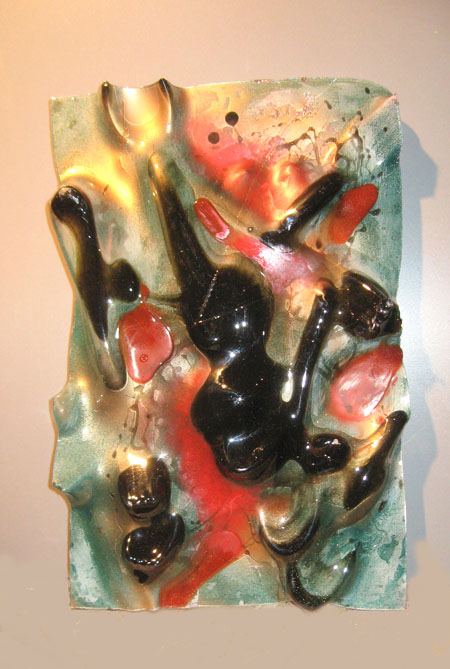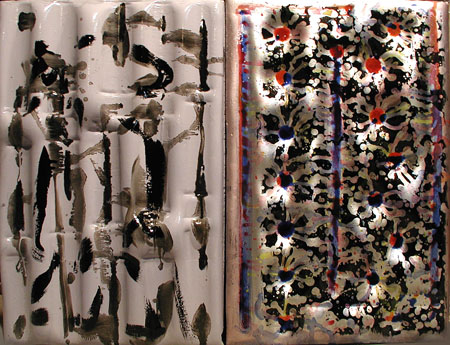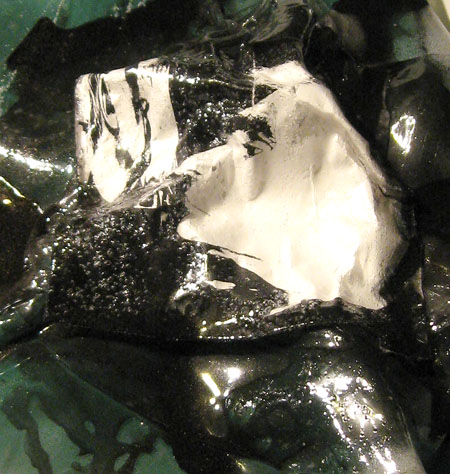For some time I have been talking about shaped plaster and a final admission that the material, even though host to a number of effects, has not held up well. I was obliged this last summer to dispose of a large number of pieces that were suffering damage, with the prospect of further degradation.
A likely alternative has been to substitute plastic for plaster – either poured or in the form of sheets that can be deformed through the application of heat. Clear sheet being more available at this time, I have been experimenting with what comes of hot plastic sagging. It’s been a kitchen thing with the oven pressed into service. I arranged some silverware on a cookie sheet and laid a thin sheet of clear Plexiglass over top. A temperature of 400 F. gave me a vacuum-formed quality as the sheet draped itself into every available declivity. I then poured black varnish into the larger depressions, and once that set, poured transparent red into a few on the other side. I sprayed a little gold (Hi Karl) and some forest green on the other. This was then backed up with an application of white.
I find the overall quality to be complex far in excess of its overall simplicity of manufacture. To be Frank, this kind of a thing is a trap for me as it comes across as “decorative”. I surely do appreciate its resemblance to the glass maker’s art but I feel that it needs to be handled by a far more flamboyant sensibility than mine.
An earlier similar example in plaster is this set of panels that were formed over tubes on the left panel and a variety of shapes on the right. Varnish was used, but in this case the underlying plaster did not allow any see-through effects.
Then, this set of four panels. Something of an aboriginal quality.
And, as an exercise, I attached a copier paper printout to a sheet with acetone and put that through the 400 F. treatment, along with an underlying layer.
This does bear somewhat on Karl’s question about the use of gold. In this case the topic is the inherent attractions found in glassiness, and of things seeming to live in an amber-like context. Does this so bear for you?





I like the four panel combination. I think it is the repeating patterns. Stained glass windows have something of this also, not so much of repetition as harmony of proportions, pieces of glass of similar sizes.
There is in anthropology the concept of the ‘raw’ and the ‘cooked’, where ‘cooked’ means brought into a cultural context. I think that a more formal pattern, as with the four pieces, acts as a way to ‘cook’ the material which otherwise might seem a bit wild.
Karl:
Maybe I can “poach” a design from somewhere.
Jay,
I do like the 4 panels a lot, their colors are beautiful! Together, they convey serenity. Aboriginal?
Be careful with fumes emitted when heating plexiglass. Use oven fan, open the windows and leave the kitchen. Do I sound like the chemical safety inspector for the blog?
Jay,
At the rate you seem to produce ideas and work, you must either have a warehouse for storage or be a major contributor to your local landfill.
I realize it’s my own personal limitation, but I’m afraid I continue to find the shiny surfaces not so much to my taste–though I rather like that crumpled face in the last image. I think there’s a huge barrier of resistance to cheap popular culture associated with plastic. I do admire and appreciate your engagement and playing with such a variety of materials. My own work has been pretty conventional (not to say boring) in that regard, and it’s only recently I’ve started to experiment more with different papers and with the gold leaf idea (as mentioned last post, the leaf is shiny but not smooth, and is printed over with ink).
I doubt that Jay has more sculptures than I have images on my external hard drives.
Bulkiness? If I remember right, June dealt with the storage issue by leaving paintings in front of her house to be picked up by however wanted them.
jay,
I think the first work you produced is rather obscene — something about all those drooping parts. I like the last one better, although I can’t quite get my eyes around all of it — some of it seems obscured in the photo. But I really liked the plaster better than the plastic — and like Birgit, I worry about the fumes and your health.
As for storage, giving things away works in southeast Portland; you might live in higher class surroundings –snort —
By the way, some of the sculptures here at the Goldwell Art Museum, “The Last Supper” and “Ghost Rider,” are of plaster — burlap was dipped in plaster, draped over a real human, and then more plaster poured over the drapery. The first ones the sculptor (Albert Szukalski, from Belgium) did were so heavy the models bent over under the weight; and so all the sculptures had to be broken up and he started over.
I think that those pieces were epoxied, or coated somehow in weatherproof material. They now sit in the open air and have for some years, without suffering any damage. A concrete piece by one of his friends was destroyed by vandals. But maybe the vandals feared the wrath of god and so didn’t turn on The Last Supper.
Folks:
Spent last evening on a front porch in Austin watching a long dog play fetch and Mexicans build houses. One of my missions for the day is to visit the Blanton Museum where the Park Place show was mounted – that and consume some more TexMex.
Plexiglass puts out the most enjoyable odor when being cut. The red stuff is like bubble gum. Proper ventilation is a must.
Steve:
It’s a little landfill and some warehouse with the occasional tree lawn exhibit thrown in. Working in plastic is like performing the Catholic mass in English. To tell the truth I much prefer the plaster, but people make temporary things out of plaster. As I may have mentioned, I am a Swarovski junkie and can’t get enough of those flashy birds that the company puts out.
More later.
Jay,
We watched a video about Tony Cragg last evening and I was reminded of your love of materials, of working “things” “stuff”. Cragg did a riff on the etymology of “material” — using ideas like maternal, the base from which all else comes, etc. His work is playful, like yours, and he takes it very seriously at the same time he’s making jokes. Like you.
Jay,
I understand the magic of plastic. Decades ago, I used to make chambers of thick Lucite for electrical recordings. I much enjoyed the transparency of the walls of the chambers.
I would stay away from epoxy. You can leave the kitchen while melting plastics in your oven; or better still invest in a small oven for your garage. But applying epoxy glue to plaster, you would be breathing the fumes and expose your skin unless you wore a space suit – autoimmune disease, skin sclerosis.